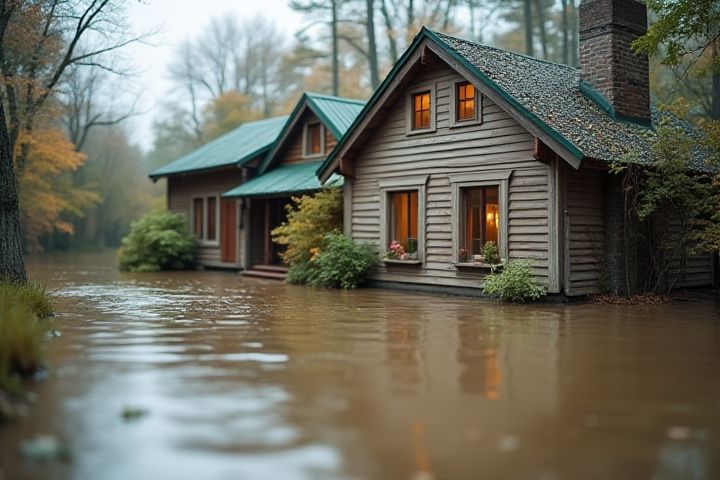
Insuring a house after a flood can be challenging, as many insurance companies impose limitations or exclusions for flood coverage in high-risk areas. Flood insurance policies typically require a waiting period before they take effect, often 30 days, making immediate coverage difficult. If your property has recently experienced flooding, it's essential to disclose this information to your insurer, as it can impact eligibility and rates. You may also consider specialized flood insurance through the National Flood Insurance Program (NFIP), or private insurers that offer more tailored policies. Understanding your local flood zone and potential risks is critical in securing the right coverage for your home.
Can We Insure A House After A Flood
Risk assessment mitigation
Insuring a house after a flood involves a thorough risk assessment to evaluate potential damages and vulnerabilities. Insurance providers often require detailed information about the property's flood history, repairs made, and mitigation measures implemented, such as elevating structures or installing sump pumps. You may also benefit from upgrading to flood-resistant materials to enhance resilience. Effective risk mitigation not only influences underwriting decisions but can also lead to lower premiums and better coverage options.
Proof of repaired damage
Insurance companies typically require proof of repaired damage before granting coverage for a house that has previously experienced flooding. This proof often includes detailed documentation such as photographs, invoices from contractors, and inspection reports that confirm repairs meet local codes and standards. You may also need to provide a flood mitigation strategy, ensuring that future risks are minimized. Properly addressing these elements demonstrates to insurers that the property is a lower risk, potentially making it easier to secure a policy.
Specialist flood insurance providers
Insuring a house after a flood can be challenging, but specialist flood insurance providers offer tailored coverage options. These insurers understand the unique risks associated with flood-damaged properties, allowing for personalized policies that include replacement cost coverage and additional living expenses. You should evaluate different providers based on their claims process, customer service reputation, and the specific coverage limits that apply to your property. Seeking quotes from multiple specialist flood insurance providers can help you find the best policy to protect your home against future flooding risks.
Increased premiums
Insuring a house after a flood often results in increased premiums due to the heightened risk associated with flood-prone areas. Insurance companies assess the potential for future claims based on past flooding events, leading to a more comprehensive evaluation of the property. You may need to explore specific flood insurance policies, which are typically required in high-risk zones, and these can carry significantly higher costs. In some cases, you might also be eligible for federal disaster assistance programs, which could provide support to mitigate the financial impact of your increased insurance expenses.
Updated flood maps
Post-flood insurance eligibility for your house often relies on updated flood maps that reflect recent changes in flood risk. These maps, maintained by the Federal Emergency Management Agency (FEMA), can impact the availability and cost of flood insurance policies. If your property is now classified as in a higher risk zone, obtaining insurance may require you to purchase flood coverage, which can be significantly more expensive. Understanding these updated flood maps is crucial for making informed decisions about safeguarding your home from future flooding events.
Government assistance programs
If your house has experienced flooding, obtaining insurance can be challenging, but government assistance programs may provide crucial support. The Federal Emergency Management Agency (FEMA) offers disaster relief funds to help homeowners recover from flooding, including low-interest loans and grants for essential repairs. Additionally, the National Flood Insurance Program (NFIP) provides flood insurance policies to properties in high-risk areas, enabling you to secure coverage even post-flood. Exploring these programs can significantly aid in your recovery and help restore your home to a safe living condition.
Deductible considerations
Insuring a house after a flood requires careful consideration of the deductible, which is the amount you must pay out-of-pocket before the insurance coverage kicks in. Flood insurance policies often have higher deductibles than standard homeowners' insurance, potentially ranging from $1,000 to $10,000. You should assess your financial situation and decide how much risk you are willing to take, as a lower deductible means higher premiums. Understanding the terms of your specific flood insurance policy, including any exclusions or limitations, is crucial to ensure adequate protection for your property in future events.
Building elevation requirements
Insuring a house after a flood often involves adhering to specific building elevation requirements set by insurance providers and local regulations. These requirements dictate that your home must be elevated above the base flood elevation (BFE) to qualify for flood insurance coverage. You may need to present documentation, such as an elevation certificate, to verify your property meets these criteria. Ensuring compliance with building elevation standards can significantly impact your insurance premiums and eligibility, so it's vital to consult with your insurance agent regarding local policies.
Community flood measures
Insuring a house after a flood can be influenced by community flood measures implemented in your area. Local governance often enforces zoning regulations, floodplain management, and infrastructure improvements such as levees and drainage systems to minimize future risks. You may find that participating in community initiatives, like the National Flood Insurance Program (NFIP), can enhance your eligibility for coverage and potentially lower premiums. Understanding these measures not only protects your investment but also contributes to the resilience of your neighborhood against future flooding events.
Coverage for future floods
After a flood, securing home insurance can be challenging, particularly in areas prone to such natural disasters. Standard homeowners insurance generally excludes flood damage, so obtaining a separate flood insurance policy becomes essential. The National Flood Insurance Program (NFIP) offers coverage specifically for flood-related losses, enabling property owners to get protection against future flooding risks. You should also consider additional coverage options, such as increased limits for personal property and basement improvements, to ensure your home is comprehensively protected.
